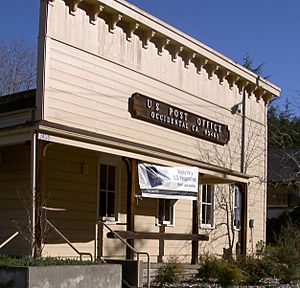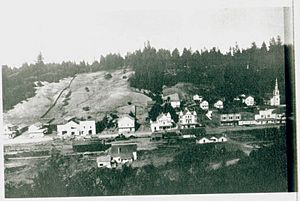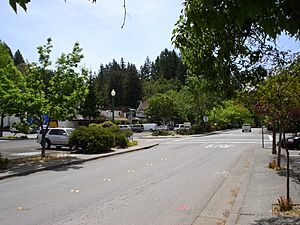Occidental, California facts for kids
Quick facts for kids
Occidental
Howards
|
|
|---|---|

Occidental, California, post office
|
|

Location in Sonoma County and the state of California
|
|
| Country | |
| State | |
| County | Sonoma |
| Area | |
| • Total | 4.966 sq mi (12.862 km2) |
| • Land | 4.966 sq mi (12.862 km2) |
| • Water | 0 sq mi (0 km2) 0% |
| Elevation | 594 ft (181 m) |
| Population
(2020)
|
|
| • Total | 1,132 |
| • Density | 227.95/sq mi (88.01/km2) |
| Time zone | UTC−8 (PST) |
| • Summer (DST) | UTC−7 (PDT) |
| ZIP code |
95465
|
| Area code(s) | 707 |
| FIPS code | 06-53266 |
| GNIS feature ID | 277568 |
Occidental is a census-designated place (CDP) in Sonoma County, California, United States. The population was 1,132 at the 2020 census, up from 1,115 at the 2010 census.
History
Founded in 1876, Occidental was a stop on the North Pacific Coast Railroad connecting Cazadero to the Sausalito ferry. In return for donating right-of-way to the railroad, a local landowner named "Dutch Bill" Howards received a lifetime railway pass, and the station was named after him.
The railway caused a rapid expansion of the timber industry, and by 1877 there were six sawmills in the Occidental area. Trains also brought vacationers from San Francisco.
Howard’s Station Cafe is a restaurant that is located at the old narrow gauge railroad stop in downtown Occidental.
Geography
Occidental has a total area of 4.97 sq mi (12.9 km2), all of it land.
Climate
The cooperative National Weather Service station reports that Occidental has cool, wet winters and warm, dry summers.
Average January temperatures range from 41.8 to 54.5 °F (5.4 to 12.5 °C) and average July temperatures range from 51.4 to 77.9 °F (10.8 to 25.5 °C). The record highest temperature was 103 °F (39.4 °C) on July 22, 2006, and the record lowest temperature was 28 °F (−2.2 °C) on March 11, 2006. There are an average of 12.8 afternoons with highs of 90 °F (32.2 °C) or higher and an average of 2.1 mornings with lows of 32 °F (0 °C) or lower.
Average annual rainfall is 55.19 inches (1,401.8 mm). The wettest "rain year" was from July 1997 to June 1998 with 102.89 inches (2,613.4 mm) and the driest was from July 2000 to June 2001 with 29.84 inches (757.9 mm). The most rainfall in one month was 36.62 inches (930.1 mm) in January 1995. The most rainfall in 24 hours was 8.51 inches (216.2 mm) on January 5, 1966. Average annual snowfall is only 0.2 inches (0.51 cm). The most snowfall was 11.0 inches (28 cm) in January 1974.
| Climate data for Occidental, California | |||||||||||||
|---|---|---|---|---|---|---|---|---|---|---|---|---|---|
| Month | Jan | Feb | Mar | Apr | May | Jun | Jul | Aug | Sep | Oct | Nov | Dec | Year |
| Mean daily maximum °F (°C) | 54.7 (12.6) |
56.8 (13.8) |
60.9 (16.1) |
63.6 (17.6) |
70.1 (21.2) |
75.9 (24.4) |
77.8 (25.4) |
77.7 (25.4) |
76.4 (24.7) |
71.4 (21.9) |
60.8 (16.0) |
54.7 (12.6) |
66.7 (19.3) |
| Mean daily minimum °F (°C) | 42.1 (5.6) |
42.5 (5.8) |
43.8 (6.6) |
43.8 (6.6) |
47.4 (8.6) |
50.6 (10.3) |
51.0 (10.6) |
52.1 (11.2) |
52.8 (11.6) |
50.8 (10.4) |
45.4 (7.4) |
42.7 (5.9) |
47.1 (8.4) |
| Average precipitation inches (mm) | 11.16 (283) |
9.18 (233) |
7.16 (182) |
3.38 (86) |
1.56 (40) |
0.47 (12) |
0.07 (1.8) |
0.24 (6.1) |
0.54 (14) |
3.26 (83) |
7.08 (180) |
10.19 (259) |
54.29 (1,379.9) |
| Average precipitation days (≥ 0.01 inch) | 11 | 10 | 11 | 6 | 4 | 1 | 0 | 1 | 2 | 5 | 9 | 11 | 71 |
| Source: Western Regional Climate Center | |||||||||||||
Demographics
| Historical population | |||
|---|---|---|---|
| Census | Pop. | %± | |
| 1880 | 97 | — | |
| 1990 | 1,300 | — | |
| 2000 | 1,272 | −2.2% | |
| 2010 | 1,115 | −12.3% | |
| 2020 | 1,132 | 1.5% | |
| 2021 (est.) | 1,126 | 1.0% | |
| US Census U.S Census 1880-1980, | |||
| Racial and ethnic composition | 2000 | 2010 | 2020 |
|---|---|---|---|
| White (non-Hispanic) | 89.15% | 85.02% | 81.98% |
| Hispanic or Latino (of any race) | 4.64% | 7.26% | 7.24% |
| Two or more races (non-Hispanic) | 2.67% | 3.77% | 7.07% |
| Asian (non-Hispanic) | 1.18% | 2.78% | 1.68% |
| Other (non-Hispanic) | 0.79% | 0.0% | 1.41% |
| Black or African American (non-Hispanic) | 0.55% | 0.63% | 0.44% |
| Native American (non-Hispanic) | 0.79% | 0.54% | 0.18% |
| Pacific Islander (non-Hispanic) | 0.24% | 0.0% | 0.0% |
2010
At the 2010 census Occidental had a population of 1,115. The population density was 224.5 inhabitants per square mile (86.7/km2). The racial makeup of Occidental was 992 (89.0%) White, 7 (0.6%) African American, 7 (0.6%) Native American, 31 (2.8%) Asian, 0 (0.0%) Pacific Islander, 23 (2.1%) from other races, and 55 (4.9%) from two or more races. Hispanic or Latino of any race were 81 people (7.3%).
The census reported that 100% of the population lived in households.
There were 532 households, 134 (25.2%) had children under the age of 18 living in them, 228 (42.9%) were opposite-sex married couples living together, 44 (8.3%) had a female householder with no husband present, 25 (4.7%) had a male householder with no wife present. There were 39 (7.3%) unmarried opposite-sex partnerships, and 14 (2.6%) same-sex married couples or partnerships. 172 households (32.3%) were one person and 40 (7.5%) had someone living alone who was 65 or older. The average household size was 2.10. There were 297 families (55.8% of households); the average family size was 2.65.
The age distribution was 192 people (17.2%) under the age of 18, 52 people (4.7%) aged 18 to 24, 264 people (23.7%) aged 25 to 44, 462 people (41.4%) aged 45 to 64, and 145 people (13.0%) who were 65 or older. The median age was 48.5 years. For every 100 females, there were 103.8 males. For every 100 females age 18 and over, there were 99.8 males.
There were 673 housing units at an average density of 135.5 per square mile (52.3/km2), of which 68.6% were owner-occupied and 31.4% were occupied by renters. The homeowner vacancy rate was 4.2%; the rental vacancy rate was 6.6%. 70.3% of the population lived in owner-occupied housing units and 29.7% lived in rental housing units.
The median household income was $64,714 (+19.8% from 2000), and the median family income was $87,759 (+30.0% from 2000). The median per capita income for the CDP was $40,903 (+57.5% from 2000). For comparison, statewide California median per capita income in the 2010 Census was $27,885 (+22.8% from 2000).
2000
At the 2000 census there were 1,272 people, 524 households, and 319 families in the CDP. The population density was 255/sq mi (99/km2). There were 632 housing units at an average density of 127/sq mi (49/km2). The racial makeup of the CDP was 92.77% White, 0.55% African American, 0.79% Native American, 1.18% Asian, 0.24% Pacific Islander, 1.57% from other races, and 2.91% from two or more races. Hispanic or Latino of any race were 4.64%.
Of the 524 households, 32.3% had children under the age of 18 living with them, 46.2% were married couples living together, 10.3% had a female householder with no husband present, and 39.1% were non-families. 27.1% of households were one person and 5.2% were one person aged 65 or older. The average household size was 2.40 and the average family size was 2.91.
The age distribution was 22.8% under the age of 18, 7.6% from 18 to 24, 27.7% from 25 to 44, 33.3% from 45 to 64, and 8.6% 65 or older. The median age was 41 years. For every 100 females, there were 99.7 males. For every 100 females age 18 and over, there were 100.0 males.
The median household income was $54,000 and the median family income was $71,375. Males had a median income of $46,806 versus $29,306 for females. The per capita income for the CDP was $25,970. About 7.9% of families and 9.8% of the population were below the poverty line, including 13.7% of those under age 18 and none of those age 65 or over.
Economy
The large number of craft breweries and wineries in the area have made Barley and Hops Tavern and Sonoma Fine Wine store in downtown Occidental local and tourist destinations.
The tool-belt manufacturing company Occidental Leather started in an Occidental barn and later moved to downtown Occidental.
The Occidental Arts and Ecology Center (OAEC) is a non-profit organization located near Occidental. Situated on an 80-acre ecological reserve near the Russian River, OAEC works with communities in the region to restore and build cultural and biological diversity.
Notable people
- Les Claypool, musician
- Nick Gravenites, musician
- Mickey Hart, musician
- Alicia Bay Laurel, artist, author and musician
- Terence McKenna, ethnobotanist
- Robert Nichols, actor
- Max Thieriot, actor, grew up in Occidental
- Kitaro, musician
- Tom Waits, musician
See also
 In Spanish: Occidental (California) para niños
In Spanish: Occidental (California) para niños




